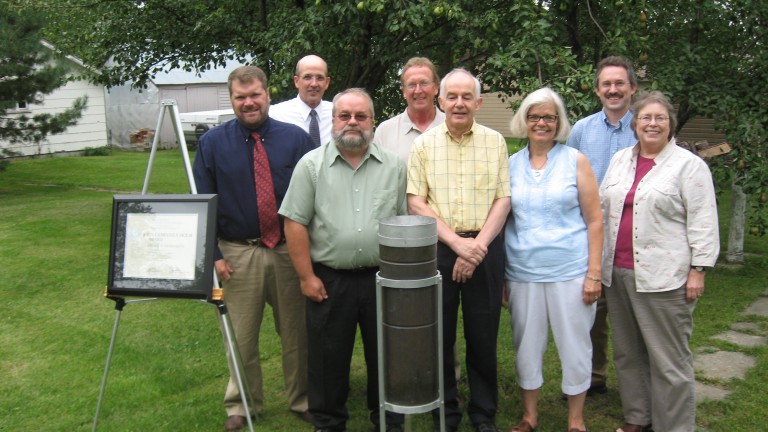Clark, South Dakota Resident Henry T. Desnoyers Honored for Contributions
to National Weather Service Volunteer Observer Program

Pictured for left to right: Jim scarlett (MIC), Tim Kearns (DAPM), Ken Gillespie (HMT), Glenn Nielsen (HMT), Henry Desnoyers, Barb Desnoyers (Henry's Wife), Dr. Dennis Todey (State Climatologist), Kathy Desnoyers (Henry's Sister)
Recognizing 25 years of service to America, NOAA’s National Weather Service has named Clark resident H.T. Desnoyers as a 2009 recipient of the agency’s John Campanius Holm Award for outstanding service in the Cooperative Weather Observer Program. The award is the agency’s second most prestigious and only 25 are presented this year to cooperative weather observers from around the country.
James Scarlett of the Aberdeen weather forecast office will present the award during a ceremony held at 2pm on August 28 in Clark. Tim Kearns of the Aberdeen office nominated Mr. Desnoyers for the award.
The National Weather Service’s Cooperative Weather Observer Program has given scientists and researchers continuous observational data since the program’s inception more than a century ago. Today, some 11,700 volunteer observers participate in the nationwide program to provide daily reports on temperature, precipitation and other weather factors such as snow depth, river levels and soil temperature.
The Clark, SD station is part of the nation's Historical Climate Network due to its quality data and long period of record. The Clark SD COOP site has been run off and on by the Desnoyers family for the last 57 years. In May of 1952, Henry's father became the Clark observer. With the help of his sister, they took observations as a family until 1961 when Henry's father passed away. Henry's sister, Kathy, took over full responsibility until she moved away to attend college in 1964.
From 1964 until 1984, the Desnoyers next door neighbor, John Wagner took the official observations. In 1984 John could no longer continue his service, so he passed the responsibility back to the Desnoyers family and Henry took over and has continued ever since. The Desnoyers family has been instrumental in continuing the long history of the Clark COOP site whose beginnings date back to 1895.
Weather records retain their importance as time goes by. Long and continuous records provide an accurate picture of a locale’s normal weather, and give climatologists and others a basis for predicting future trends. These data are invaluable for scientists studying floods, droughts and heat and cold waves. At the end of each month, observers mail their records to the National Climatic Data Center for publication in “Climatological Data” or “Hourly Precipitation Data.”
The first extensive network of cooperative stations was set up in the 1890s as a result of an 1890 act of Congress that established the U.S. Weather Bureau. Many of the stations have even longer histories. John Campanius Holm’s weather records, taken without benefit of instruments in 1644 and 1645, were the earliest known recorded observations in the United States.
Many historic figures have maintained weather records, including Benjamin Franklin, George Washington and Thomas Jefferson. Jefferson maintained an almost unbroken record of weather observations between 1776 and 1816, and Washington took weather observations just a few days before he died. The Jefferson and Holm awards are named for these weather observation pioneers.
The National Oceanic and Atmospheric Administration, an agency of the U.S. Department of Commerce, is celebrating 200 years of science and service to the nation. From establishment of the U.S. Coast and Geodetic Survey by Thomas Jefferson in 1807 to formation of the Weather Bureau and the Commission of Fish and Fisheries in the 1870s, much of America's scientific heritage is rooted in NOAA.
NOAA is dedicated to enhancing economic security and national safety through the prediction and research of weather and climate-related events and information service delivery for transportation, and by providing environmental stewardship of our nation's coastal and marine resources. Through the emerging Global Earth Observation System of Systems (GEOSS), NOAA is working with its federal partners, more than 70 countries and the European Commission to develop a global monitoring network that is as integrated as the planet it observes, predicts and protects.

